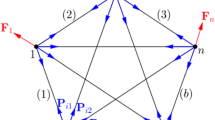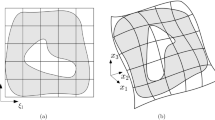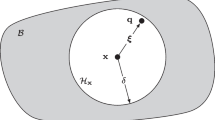Abstract
This paper presents a method to find all intersections between curved lines such as structural line elements and finite element meshes with intentions to generate smaller, non-compatible, line cells (e.g. bar elements) between crossings. The intersection finding algorithm works for two and three-dimensional meshes constituted by linear, quadratic or higher order elements. Using the proposed algorithm, meshes can then be automatically prepared for finite element analyses with techniques for embedding elements within others or analyses that require lines within solids. The application of the method is demonstrated by a number of numerical examples illustrating its capabilities in handling complex geometries, relative speed and convenience.























Similar content being viewed by others
References
Barzegar F, Maddipudi S (1994) Generating reinforcement in FE modeling of concrete structures. J Struct Eng 120(5):1656–1662. doi:10.1061/(ASCE)0733-9445(1994)120:5(1656)
Belytschko T, Liu WK, Moran B (2000) Nonlinear finite elements for continua and structures. Nonlinear finite elements for continua and structures. Wiley, New York
CGAL P (2014) CGAL User and Reference Manual, 4.4 edn. CGAL Editorial Board. http://doc.cgal.org/4.4/Manual/packages.html
Cottrell J, Hughes T, Bazilevs Y (2009) Isogeometric analysis: toward integration of CAD and FEA. Wiley, New York. doi:10.1002/9780470749081
Durand R (2008) Three-dimensional analysis of geotechnical structures subject to reinforcement and drainage. Ph.D. thesis, University of Brasilia
Durand R, Farias M, Pedroso D (2015) Modelling the strengthening of solids with incompatible line finite elements. Comput Struct. Under review
Elwi A, Hrudey T (1989) Finite element model for curved embedded reinforcement. J Eng Mech 115(4):740–754. doi:10.1061/(ASCE)0733-9399(1989)115:4(740)
Farias MM, Naylor DJ (1998) Safety analysis using finite elements. Comput Geotech 22(2):165–181. doi:10.1016/S0266-352X(98)00005-6
Hartl H (2002) Development of a continuum-mechanics-based tool for 3d finite element analysis of reinforced concrete structures and application to problems of soil-structure interaction. Ph.D. thesis, Graz University of Technology, Institute of Structural Concrete
Hughes T (2000) The finite element method: linear static and dynamic finite element analysis. Dover civil and mechanical engineering series. Dover Publications, New York
Hughes T, Cottrell J, Bazilevs Y (2005) Isogeometric analysis: cad, finite elements, NURBS, exact geometry and mesh refinement. Comput Methods Appl Mech Eng 194(39–41):4135–4195. doi:10.1016/j.cma.2004.10.008
Jendele L, Cervenka J (2006) Finite element modelling of reinforcement with bond. Comput Struct 84(28):1780–1791. doi:10.1016/j.compstruc.2006.04.010
Markou G, Papadrakakis M (2013) Computationally efficient 3D finite element modeling of RC structures. Comput Concr 12(4):443–498. doi:10.12989/cac.2013.12.4.443
Paraview D (2014) ParaView Data analysis and visualisation application. http://www.paraview.org
Phillips D, Zienkiewicz O (1976) Finite element non-linear analysis of concrete structures. ICE Proc 61(1):59–88. doi:10.1680/iicep.1976.3503
Wriggers P (2008) Nonlinear finite element methods. Springer, New York. doi:10.1007/978-3-540-71001-1
Zhou Y, Cheuk C, Tham L (2009) An embedded bond-slip model for finite element modelling of soil-nail interaction. Comput Geotech 36(6):1090–1097. doi:10.1016/j.compgeo.2009.03.002
Acknowledgments
The support of the Australian Research Council (ARC), under grant DE120100163, and the Brazilian Research Council (CNPq) are gratefully acknowledged.
Author information
Authors and Affiliations
Corresponding author
Additional information
Australian Research Council grant DE120100163 and Brazilian Reseach Council CNPq.
Rights and permissions
About this article
Cite this article
Durand, R., Farias, M.M. & Pedroso, D.M. Computing intersections between non-compatible curves and finite elements. Comput Mech 56, 463–475 (2015). https://doi.org/10.1007/s00466-015-1181-y
Received:
Accepted:
Published:
Issue Date:
DOI: https://doi.org/10.1007/s00466-015-1181-y




